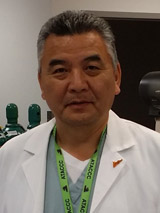


Posted April 18, 2016
Perenlei Enkhbaatar, M.D., Ph.D., University of Texas Medical Branch, Galveston, TX
 Inhalation of smoke during combat is especially detrimental to Soldiers who have incurred burns. In the last few years, the incidence of military burns has nearly doubled.1 This trauma can result in the life-threatening onset of Acute Respiratory Distress Syndrome (ARDS), known during the Vietnam War as "shock lung.†The main symptom of ARDS is shortness of breath that is caused by fluid build-up in the lungs that, in turn, leads to decreased oxygen and increased carbon dioxide in the bloodstream and organs. In the US, more than one million burn injuries occur every year1 and 20% to 35% of patients admitted to burn centers suffer from smoke inhalation.2 Studies show that ARDS often results in early death (a 28-day mortality)3. The pathophysiology of airway dysfunction and its contribution to lung parenchymal damage following smoke inhalation is not completely understood. Consequently, effective therapy has not been standardized.
Inhalation of smoke during combat is especially detrimental to Soldiers who have incurred burns. In the last few years, the incidence of military burns has nearly doubled.1 This trauma can result in the life-threatening onset of Acute Respiratory Distress Syndrome (ARDS), known during the Vietnam War as "shock lung.†The main symptom of ARDS is shortness of breath that is caused by fluid build-up in the lungs that, in turn, leads to decreased oxygen and increased carbon dioxide in the bloodstream and organs. In the US, more than one million burn injuries occur every year1 and 20% to 35% of patients admitted to burn centers suffer from smoke inhalation.2 Studies show that ARDS often results in early death (a 28-day mortality)3. The pathophysiology of airway dysfunction and its contribution to lung parenchymal damage following smoke inhalation is not completely understood. Consequently, effective therapy has not been standardized.
Dr. Perenlei Enkhbaatar at the University of Texas Medical Branch is an expert in the field of critical care medicine, with 22 years of research experience and 12 years of clinical experience in hematology and pulmonary medicine. With FY11 and FY12 funding from the Military Burn Research Program, Dr. Enkhbaatar is testing the efficacy of nebulized (or mist-inhaled) epinephrine in burn patients with smoke inhalation at the Shriner's Hospital for Children, Galveston, Texas. His hypotheses are that pathological changes in the airway, following smoke inhalation and burn, significantly contribute to lung parenchymal damage and that nebulized epinephrine will alleviate the resulting ARDS by limiting airway hyperemia and antagonizing the bronchial constriction. Dr. Enkhbaatar anticipates that nebulized epinephrine will be superior to that of nebulized beta-2 adrenergic receptor agonist albuterol, which is currently used for this therapeutic indication, because albuterol lacks an alpha receptor component that is crucial to reducing augmented airway blood flow.
Using a sheep model with burn- and smoke inhalation-induced ARDS, preliminary investigations comparing the effects of nebulized epinephrine, nebulized albuterol, and nebulized phenylephrine found that nebulized epinephrine administered every four hours significantly attenuated the degree of acute lung injury following 40% total body surface area skin burn and cotton smoke inhalation. Nebulized albuterol administered every four hours failed to do so. Nebulized phenylephrine administered every four hours reduced the pulmonary vascular permeability to the same extent as nebulized epinephrine, but failed to improve pulmonary gas exchange. Based on the results from both human and clinically relevant, large animal studies, the PI believes that nebulized epinephrine is an effective, safe, readily available, and cost-efficient therapy for treatment of burn patients with smoke inhalation. The PI also believes that nebulized epinephrine can be effectively used for airway management during long-term evacualtion of Soldiers with burn and smoke inhalation injury.
In another innovative project funded by the Military Burn Research Program in FY11, Dr. Enkhbaatar and his colleagues are investigating whether simple administration of high doses of alpha-tocopherol, which is the form of vitamin E that is preferentially absorbed and accumulated in humans, will prevent or reverse the oxidative state present in burn patients. The basis for this research stems from earlier findings that thermal injury significantly depletes plasma alpha-tocopherol in burn patients. Preliminary clinical findings obtained thus far indicate the alpha-tocopherol treated patients show better pulmonary function. If the conclusion of this study shows statistical significance of the alpha-tocopherol treated group faring better in pulmonary function, a very simple and cost-effective therapy could be quickly implemented for burn patients. Studies are ongoing.
References
1Peck, MD. 2011. Epidemiology of burns throughout the world. Part I: Distribution and risk factors. Burns 37(7):1087-1100.
2Cahalane M and Demling RH. 1984. Early respiratory abnormalities from smoke inhalation. JAMA 251(6):771-773.
3Jozwiak M, Silva S, Persichini R, Anguel N, Osman D, Richard C, Teboul JL, and Monnet X. 2013. Extravascular lung water is an independent prognostic factor in patients with acute respiratory distress syndrome. Crit Care Med 41(2):472-480.














